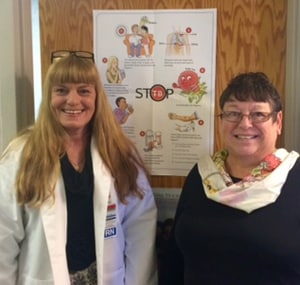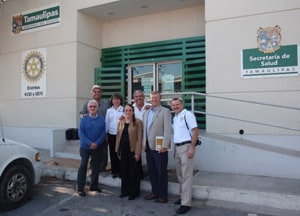Building Partnerships
‹View Table of Contents

Since 2008, the downtown metropolitan-Atlanta area has struggled to control an outbreak of TB among people experiencing homelessness. People experiencing homelessness face many challenges throughout their day. They face obstacles to obtaining food, adequate shelter, and health care. Behavioral and mental health challenges can also present a unique set of problems when trying to identify those with TB infection and disease and provide adequate treatment. Infection control within homeless service agencies, particularly overnight shelters, is also challenging to achieve.
As the outbreak progressed in 2014, it became apparent that Atlanta service providers needed to come together to reduce the burden of disease. Tom Andrews, as the President of the largest Health Care for the Homeless grant recipient in Atlanta, led the effort to establish the Metro Atlanta TB Task Force. He invited shelter directors, clinic managers, representatives from the State of Georgia, City of Atlanta, Fulton and DeKalb Counties, Emory University, Grady Health, Atlanta-area HUD-funded Continuum of Care representative, and staff from Mercy Care.
Through this collaboration, Dr. Neela Goswami from Emory led an effort to develop new TB guidelines for the city of Atlanta. A shelter check list was established so that each overnight facility could work toward reducing risk. Dr. Rose Sales from Department of Public Health and Dr. Goswami were also instrumental in the development of educational materials that were distributed city-wide. The health department and Mercy Care began to share the burden of screening patients for active TB disease and testing for latent TB infection. Systems were also put in place to notify people when they were due for additional screening by the health department.
The outbreak is not over, but the incident cases are greatly reduced. There were 44 active TB cases identified among the shelter population in 2014. This has decreased to 16 active TB cases in 2015. Four of the cases in 2015 were diagnosed as a result of shelter-based screening protocols. Tom’s leadership, efforts in establishing communication between service agencies and health departments, and relentless persistence brought everyone together to reduce TB transmission and work toward ending the outbreak completely.

Ann Cronin is DTBE’s Associate Director for Policy. She addresses the numerous policy and programmatic challenges confronting domestic TB control and prevention. In 2015, Ann and her team’s dedication and passion for domestic TB control efforts intensified and were channeled into a single, critical document, the National Action Plan for Combating Multidrug-resistant Tuberculosis(MDR TB) (NAP). Although no funding was identified to support the document at the time of its launch, the NAP provided an essential roadmap for our collective efforts to address multidrug-resistant (MDR) TB. The plan addresses MDR TB both domestically and globally, for the next five years.
Ann and her team were instrumental in the development and launch of the NAP’s first goal. The first goal of the NAP is to strengthen domestic capacity to combat MDR TB. Throughout the development of the NAP, the team successfully built new partnerships and engaged existing partners to provide technical advice on the relevant content. Ann sought guidance from DTBE’s partners. One of the document’s strengths is in the collective response from the partnership that Ann and her team worked to achieve.
Despite the emphasis on MDR TB in its title, Ann successfully expanded the focus of the document to include drug-resistant (DR) TB. This expanded focus recognizes the increasing numbers of individuals with mono-resistant TB (resistant to INH, primarily). It would not have been included had Ann and her team not listened to partners who pushed for and effectively argued for this expanded scope.
The NAP outlines significant milestones for achieving the stated activities for strengthening domestic capacity to combat DR TB. The milestones include:
- Upgrade TB surveillance to ensure complete and accurate detection of DR TB;
- Strengthen state and local capacity to prevent transmission of DR TB; and
- Ensure that patients with DR TB receive treatment until cured.
Each of these milestones, and the steps required to achieve successful execution, will continue to require a commitment to partnerships and maximizing scarce or limited resources. This effort to address and support domestic TB control efforts would not have had the visibility and significant infusion of national-level significance without the work of Ann, a true TB Elimination Champion.

Maureen Donovan, RN, MA has been a nurse consultant with the State of Maryland Center for TB Control and Prevention for over 20 years. During that time, her sensitivity to the needs of nursing and outreach staff at city and county health departments has created successful working relationships between the local health departments and the state TB program.
Building a functional and sustainable relationship between local health departments and state health departments is critical to the goal of TB elimination in the United States. These partnerships do not become sustainable through formal contracts or memorandums of understanding. They stand the test of time through the mutual understanding that state consultants are there to assist and support local programs. Maureen’s efforts have done much to establish this base of respect and trust in Maryland.
Maureen has worked to strengthen partnerships in Maryland by providing employees new to local TB programs with at least one personal, face-to-face orientation session. During the session, basic policies and procedures are reviewed. In doing so, Maureen encourages those not familiar with TB case management to call and discuss issues and concerns. She has coordinated regional training activities to encourage networking among colleagues. She has supported case and cohort reviews of all TB patients diagnosed and cared for in the state. Maureen has also led the training of local health departments on the use of IGRA testing in partnership with the Maryland Mycobacteriology Laboratory staff.

Located between Boston and Springfield, MA, Harrington Hospital’s TB Clinic has managed to survive during times when major budget cuts in public health funding have led to the closure of other clinics throughout the state. This is due to the unique collaborations between a not-for-profit community-based hospital, the Massachusetts Department of Public Health TB Division, and eight local town boards of health (LBOH).
Despite significant budget cuts at both state and federal levels, Harrington Hospital has maintained their pledge to the prevention and control of TB. The clinic is staffed on a part-time basis by 3 people: an MD, a medical office assistant, and an RN. The TB Clinic RN also serves as the Public Health RN for the eight LBOH’s. Because of this, patients can be seen in both the clinic and home setting for Directly Observed Therapy (DOT) visits and LBOH RN case management. This allows the clinic nurse to develop holistic plans of care for TB patients and their families. The physical, emotional, psychological, and cultural needs of patients are taken into consideration when plans are developed.
The preventive health/TB clinic is also the Vaccine for Children Program (VFC) provider on behalf of the eight LBOH’s. This allows Harrington Hospital to provide much needed vaccinations and assistance with health care coverage to a population that is often medically underserved. The symbiotic relationship between the hospital’s TB clinic and local and state public health departments fosters engagements of local church and community organizations. These organizations are often called upon for assistance with other patient and family needs, such as food, clothing, and shelter. This local TB prevention and treatment program is an asset to the community.

The Houston Bureau of TB African-American Project Team has been at the forefront of providing TB education to agencies located within the city’s African-American community. Since the team’s inception, a significant decline in TB among the African-American population has been reported, from 34% to 26%, from 2008 to 2015, respectively.
Each year, the Team comes up with innovative methods to reach out to the African-American community to more effectively fight TB. The team’s activities include analyzing genotype patterns for clustered cases in the Houston community, then targeting education and training. The team has identified new agencies to partner with, such as drug abuse centers, shelters, churches, and affordable housing programs. Additionally, the team provides education and tests for TB at targeted testing events in the community, with ever increasing numbers of patients identified and treated for latent TB infection.
The Team makes it a priority to share knowledge and lessons learned with others; they have taught others to target education efforts based on the local epidemiology. They have developed training tools that other programs can benefit from. The team has also worked with federal, state, and local governments to maintain funding. They continue to generate high energy by being motivated, innovative, and dedicated.

Karen Johnson, RN, is an Immunization Coordinator/Public Health Nurse Sr. at the Virginia Department of Health, Rappahannock-Rapidan Health District. She has built strong community partnerships through coordination of care with the local Department of Social Services and primary care physicians. These relationships have assisted in providing food and shelter to patients in need.
Karen is always willing to case manage unique cases that need extra coordination of resources and education. She assists with care for the mental and physical needs of each patient. This has involved reaching out to and collaborating care with the local Community Services Board. Karen has gone grocery shopping and visited the local food pantry to support patients. She works with partners to find long-term housing solutions for those who need assistance.
Focusing on prevention strategies has been a key component of Karen’s practice. She has coordinated the update of testing protocols with local home health agencies, daycare centers, and assisted living facilities. She has made herself available to these partners and provided them with additional training, as needed.
Karen has maximized resources and expanded testing and treatment by helping with other county intakes within the Rappahannock-Rapidan Health District. She has conducted DOT visits and provided coordination of care. Karen also supports infection control by coordinating care with local emergency rooms. She provides assistance with isolation precautions and isolation termination clearances for the hospitals and emergency medical services. In addition to these things, she coordinates discharge care for TB patients to ensure medication delivery and continued services.

The Rio Grande border area has one of the highest rates of TB in either Mexico or the United States. With over 65 million annual border crossings between Mexico and Texas, this creates an environment ripe for a bi-national TB crisis.
Three bi-national rotary clubs and two state governments worked together to save lives along the 1200 mile border in Mexico from California to Texas. The Rotary Clubs of Reynosa and Nuevo Laredo Reforma lobbied the Tamaulipas State Governor and Minister of Health for a new building dedicated to the diagnosis and treatment of TB. The State of Texas provided guidance, advice, and support. The Rotary Clubs of Austin University Area and Reynosa provided the diagnostic equipment, supplies, and an extensive public education effort. These efforts were funded by a Rotary Foundation “Health, Hunger, and Humanities” grant.
The partners developed an integrated, four-step effort for the identification and treatment of TB:
- Identification: To get people with TB symptoms to come in for testing, a community education program was developed to reduce the stigma of TB.
- Evaluation: When a person with TB symptoms arrives in the clinic, a digital X-ray is taken to provide faster results. These results can then be quickly shared with health care professionals.
- Diagnosis: Sputum smears are submitted to confirm the TB diagnosis and sputum is cultured to determine drug sensitivities.
- Treatment: To assure successful treatment, Direct Observation of Therapy (DOT) is provided. To assist with treatment, consultation with a nutritionist and a psychologist are also provided.
The clinic has achieved remarkable results. According to Dr. Monserrato Garcia, head of the State of Tamaulipas Tuberculous Unit, the area has seen about a 60% decline in the number of patients who have stopped TB treatment. The rate of death from TB disease has dropped by almost 80%.
To learn more about this project, visit http://www.austinuniversityrotary.org/Page/our-projects.

As the Executive Director and Board Secretary of TB Photovoice, Teresa Rugg is a shining example of a TB Champion. TB Photovoice is an organization that aims to improve the overall health of individuals and communities by using images, stories, and dialogue to give a powerful voice to people affected by TB. Through her work with TB Photovoice, Teresa has built partnerships with TB survivors and their families, health departments, media outlets, TB organizations, anti-poverty organizations, schools, churches, and a network of technology professionals.
TB Photovoice is more than an outlet for TB survivors to share their stories. Most recently, with funding from the Firland Foundation, TB Photovoice completed a project, TB Voices. TB Voices focused on TB survivors or those affected by TB in a two-county area of Washington State. With great sensitivity and respect, Teresa and the leadership of TB Photovoice have identified recurrent themes in each story. These themes have helped develop an innovative TB awareness, prevention, and support campaign. Rugg’s vision to create an interactive website and a social media forum for people impacted by TB was realized in the fall of 2015 through a partnership with the technology nonprofit Seattle GiveCamp.
Teresa travels globally to present TB survivor stories and share the mission of TB Photovoice. She is dedicated to spreading the message to as many people as she can, building partnerships along the way. Recently, she helped promote Stop TB Partnership’s new guide to end language that stigmatizes people with TB disease.
For the past two years, the Texas Department of State Health Services (TDSHS) Laboratory in Austin, Texas has provided full service TB testing for Louisiana’s public health system. These services have included AFB smear, rapid direct testing, culture, identification of positive cultures, drug susceptibility testing (DST) of M. tuberculosis complex (MTBC) isolates, and MTBC genotype referral.
This is the not the first time the TDSHS Mycobacteriology Laboratory has assisted Louisiana in TB testing. In September 2005, the Louisiana TB Control Program asked the TDSHS Laboratory to perform TB testing for Louisiana’s public health system after Hurricane Katrina. The hurricane had forced the state’s only public health laboratory (PHL) with capacity for TB testing to shut down.
The staff in the TDSHS Mycobacteriology Laboratory readily accepted the work in order to assist Louisiana. Because this event was an emergency, administrative duties that accompanied specimen testing were very time-consuming. The TDSHS Mycobacteriology Laboratory spent a significant amount of time coordinating requests from Louisiana. They also assisted in directing specimens to the laboratory.
During 2007, in preparation for the Shreveport, Louisiana laboratory to open as the new state laboratory, the TDSHS Laboratory hosted technologists from the Shreveport regional laboratory for a week long mycobacteriology training. They also shipped unprocessed split specimens to Shreveport for several months to assist with validation of TB testing. The Shreveport laboratory was eventually accredited and implemented TB testing in March 2009. From September 2005 to 2009, the TDSHS Mycobacteriology Laboratory performed TB testing on over 16,000 clinical specimens from Louisiana. This was quite an accomplishment for the TDSHS Mycobacteriology Laboratory and staff.
One of the greatest lessons learned from this experience is the importance of partnerships. Having a well-established partnership like the one that now exists between Texas and Louisiana is important in preparing for future emergencies.